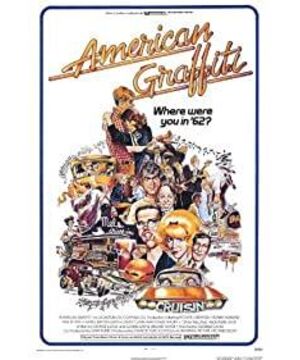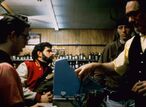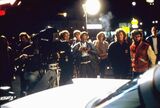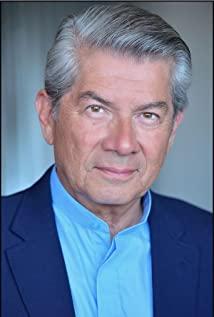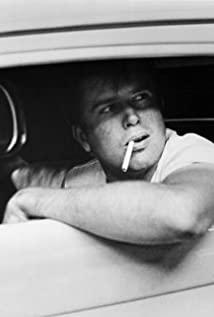If "Once Upon a Time in America" is a reminiscence of the United States in childhood, then "American Style Painting" is a letter-and-writing portrait of America in adolescence. It's hard to believe that "American Graffiti" (American Graffiti) came from Lucas. Because there is no visual spectacle, special effects, or action scenes like "Star Wars" in this 1973 movie. It is more like a prose poem chanting youth, a sweet, sad, and casual old-fashioned song.
"Graffiti" originally referred to the graffiti on the wall, which included both children's innocent essays and the spraying of paint by young people. Translated into "style painting", it is too literary and orthodox. The whole movie is actually the graffiti of youth. With their enthusiasm, restlessness and confusion, they casually sway on the white paper of their own destiny, and inadvertently, the marks of the entire era have been engraved in it.
It was a small town on the west coast of the United States in the 1960s. Four good friends who had just graduated from high school, Steve, Curt, John, and Terry, were all facing a crossroads in their lives. This is an era of youthful youth, no Kennedy assassination, no Vietnam War, no black civil rights movement, no Watergate incident... All young people have to do is to drive in cool cars on the streets, drive cars, listen to rock music, and soak in mm.
Of the four people, Steve and Curt are good boys with good grades. After this last night, they will leave their hometown to go to university in the east. The sturdy and handsome John is like the old Elvis or James Dean, in a white T-shirt, and loves street cars; while the thin Terry wears a pair of glasses, but has a simple mind and has never been favored by girls. When Steve was about to entrust his beautiful Ford to Terry for safekeeping, Terry was ecstatic and wanted to drive to get a mm right away. The four people's summer night journey began. At the end of the film, when Curt was about to get on the plane, John smiled and said to him: "Maybe you think you are about to become a big man, but in my opinion, you are still a little punk." Especially a small mouth.
The final subtitles appear: John Miller was hit and killed by a drunk driver in 1964; Terry disappeared in a battle near Saigon, Vietnam in 1965; Steve moved to California and became an insurance broker; Curt became Writer, living in Canada...
"American Style Painting" can be regarded as Lucas's youth autobiography. Back then, George Lucas himself lived in a small town called "Monteto" in California, where he spent his teenage years. Lucas was also a young and frivolous. He liked to drive a modified car, listen to rock music, go for a ride on the streets, pick up girls, and speed up the car. Old-fashioned rock and old cars have become a symbol of this generation before the Vietnam War. From the beginning of the film, it was accompanied by Bill Harry's "Rock Around the Clock" (Rock Around the Clock), and the entire movie was accompanied by songs played by DJ "Werewolf". The United States at that time, the youth at that time, did not have the turmoil of the contemporary era, and the whole film was shrouded in a touch of dazedness and a touch of joy and sorrow. It is fresh and pleasant like a layer of water vapor floating in the summer night. When you hear John sneer at the "Beach Boys" band on the radio, saying that rock is dead; when you hear Curt lament "Leaving the old home in order to find a new home, and giving up the current life in order to find a new life," It's not worth abandoning old friends in order to make new friends." Shi, I couldn't believe this was watching a Lucas movie. That kind of timelessness, humor, and calmness cannot be brought to you by later "Star Wars". Of course, graffiti is messy and random, but it is messy and full of spirituality, but it is random and completely natural. Watching "American Style Painting", you may naturally think of Luo Dayou's songs (especially the song "Childhood") and "Sunny Days". According to Haruki Murakami’s novels, at that time, “the world was much simpler. Efforts should be rewarded, promises should be fulfilled, and beauty should be retained.”
However, all youth will eventually go away, just as the fragrance will eventually dissipate, and the morning dew will evaporate on the grass. As a symbol of the times, Elvis was dead and died of narcotics; as a symbol of the times, James Dean was dead, and died in a car accident, just like John in the movie. If you can't bear to see youth dissipate, the best way is to die when you are young. Or, like Steve, walked out of his hometown, became the mainstream of society, and became ordinary people who had forgotten their dreams and pursued reality. And Terry, he is more like a metaphor for the scar called "Vietnam" in the United States. But whether it is John, Steve, Terry or Kurt, there is no doubt that there is a shadow of Lucas himself. That is his wild youth, love youth, shy youth, contemplative youth...
In the film, the blonde girl Curt has been pursuing is like a symbol, intriguing. She looked so perfect to Kurt, and so ambiguous. Some people say that she is the wife of the owner of a jewelry store, and some people say that she is a very expensive prostitute. At the end, the blonde girl called Curt, but refused to reveal any news about herself. Isn't this like the era away from us? The perfection of shadows and shadows, the charming and charming, it seems that it has never existed, and it seems incomparably true.
View more about American Graffiti reviews


